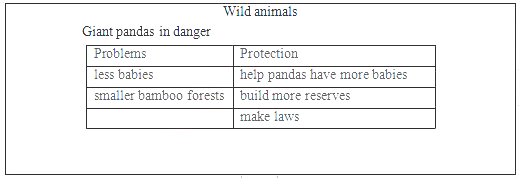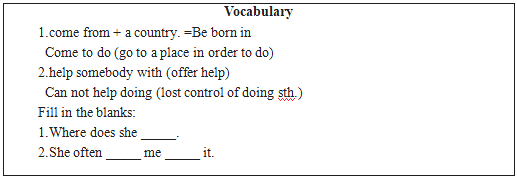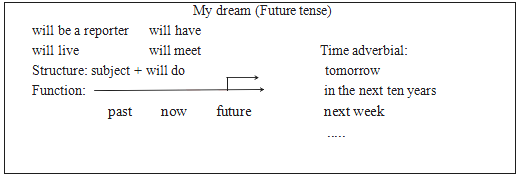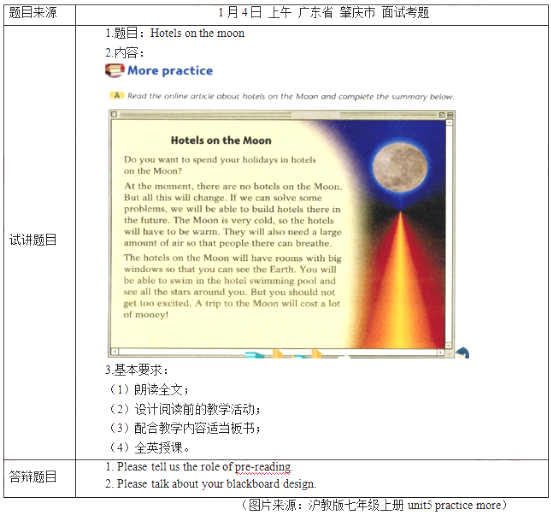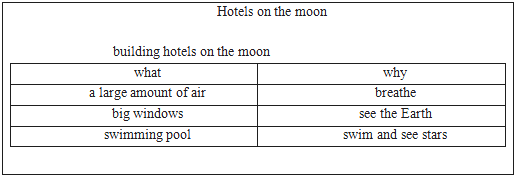|
2019下半年初中英语教师资格证面试真题及答案试讲题目1.题目:Wild animals 2.内容: Sadly, giant pandas face serious problems in the wild. For example, it is very difficult for pandas to have babies, and many baby pandas die when they are very young. Also, giant pandas live mainly on a special kind of bamboo. However, the bamboo forests are becoming smaller and smaller. As a result, pandas may not have a place to live or food to eat. Giant pandas are now in danger. We should take action right away. Here are some ideas. 1. help pandas have more babies; 2. build more panda reserves; 3. make laws to protect pandas. 3.基本要求: (1)朗读全文; (2)设计引导学生进行预测的教学活动; (3)配合教学内容适当板书; (4)全英授课。 答辩题目1. How should we communicate with students? 2. Please talk about your own personality. Are you outgoing or introverted? 二、考题解析 【教案】 Wild animals Teaching aims: Knowledge aims: Students can understand the content of the listening material. Students can be familiar with the present situation of giant pandas. Ability aim: Students will develop their listening abilities of catching key words. Emotional aim: Students can foster the awareness of protecting wild and endangered animals. Key and difficult points: Key point: How to understand the listening material. Difficult point: How to foster the awareness of protecting wild animals. Teaching procedures: Step 1: Warming-up 1. Greetings. 2. Let students enjoy a song named Do Re Mi and ask them what is followed by doe. The song is like this: Doe, a deer, a female deer. Ray, a drop of golden sun. Me, a name I call myself. Far, a long, long way to run. Sew, a needle pulling thread. La, a note to follow Sew. Tea, a drink with jam and bread. That will bring us back to Do (oh-oh-oh). Ask students to answer the question. Then tell them that elk is a kind of endangered animal and lead in the topic. Step 2: Pre-listening Show an interesting video clip of a cute giant panda named Qingyi, who is a social media star. And ask students a question, “What do you know about giant pandas?” Then ask students to predict the main idea of the listening material according to the video. Step 3: While-listening 1. Extensive listening Read the passage for students and ask them to find the main idea of the listening material. Then invite one student to write the answer on the blackboard. 2. Intensive listening Play the tape and ask students to answer two questions: Q1: What problem do giant pandas face? Q2: How should we protect giant pandas, according to the passage? Then lead students to fill in the chart on the blackboard. Step 4: Post-listening Ask students to design a slogan for protecting giant pandas in groups of four and encourage students to be creative. 5 minutes are given for discussion. Then invite some groups to share and explain. Step 5: Summary and Homework Summary: invite a student to be a little teacher and summarize today’s lesson. Ask students to protect wild and endangered animals. Homework: ask students to design a poster of protecting wild animals. Blackboard design:
Teaching reflection 试讲题目2.题目:Attributive clause 2.内容:
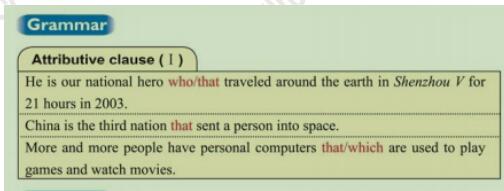
3.基本要求: (1)根据所给材料,设计语法相关的教学活动; (2)配合教学内容适当板书; (3)试讲时间10分钟; (4)全英授课。 答辩题目1.请谈谈语法教学中的常见教学方法。 2.本堂课的难点在哪里? (注:以上图片节选自仁爱版九年级上册第4单元第103页) 二、考题解析 【教案】 National heroes Teaching aims: Knowledge aim: Students can understand the meaning and function of attributive clause. Ability aim: Students are able to improve their logical thinking and inductive ability. Emotional aim: Students will be more interested and confident in English learning. Key and difficult point: Key point: The improvement in understanding the meaning and function of attributive clause. Difficult point: How to improve their inductive ability and be confident to express themselves. Teaching procedure: Step 1: Warming-up 1. Greetings. 2. Lead students to sing a song named You Raise Me Up. 3. Ask them if there is something that can raise them up to lead out topic. Step 2: Presentation 1. Ask students to read the passage to get the main idea and underline the sentences they may not understand. 2. Write down the target sentences on the blackboard and ask students to observe and discuss the similarities and differences. 3. Explain and conclude the definition, structure and rules of attributive clause. The attributive clause is used to modify a noun or pronoun before it. The structure is “antecedent + relative words + clause”. When the antecedent is a person, the relative word should be “who” or “that”. When the antecedent is a thing, the relative word should be “which” or “that”. Step 3: Practice Mechanical drill: Lead students to fill in the blanks on the screen. Check answers later. Give encouragement. Meaningful drill: Ask them to describe the pictures on the screen. Invite a few students to answer. Step 4: Production Discussion: Make a discussion in groups of 4 about what they learn from these national heroes. They should try to use attributive clause as much as possible. 5 minutes are given before inviting one or two group representatives to share. Step 5: Summary and Homework Summary: ask a student to help conclude the content of the lesson and summarize together. Homework: ask students to share the story of astronauts to their parents and write a short composition about their feelings. Also, they need to use attributive clause in the article. Blackboard design:
Teaching reflection 试讲题目3.题目:Good Manners 2.内容: (Daniel is hosting the school radio show this week. He is interviewing Jenny, a Grade 9 student, who has recently visited the UK.) Daniel: Hi, everyone. Today we’ve invited Jenny to talk about manners in the UK. What’s the proper way to greet people there, Jenny? Jenny: Well, British people say “hello” or “nice to meet you” and shake your hand when they meet you for the first time. Daniel: Do they greet people with a kiss? Jenny: No. British people only greet relatives or close friends with a kiss. Daniel: How do people start a conversation? Jenny: They talk about the weather, holidays, music, books or something else. But please avoid subjects like age, weight or money. 3.基本要求: (1)有感情地朗读所给材料; (2)根据该段落的内容,设计相应的阅读教学活动; (3)全英授课。 答辩题目1.教师的主要职责是什么? 2.如何实现本堂课的情感目标? 二、考题解析 【教案】 Good manners Teaching aims: Knowledge aim: Students can get to know the content of this passage. Ability aim: Students can improve their reading and speaking abilities. Emotional aims: Students will improve their awareness of being polite. Students can arouse their interest and confidence of English learning. Key and difficult point: Key point: The improvement of oral English and understanding of this passage. Difficult point: How to cultivate their awareness of using polite manners and put it into practice. Teaching procedure: Step 1: Warming-up 1. Greetings. 2. Show some pictures about different greeting manners around the world. 3. Ask students how much they know about it and lead out the topic. Step 2: Pre-reading 1. Introduce some background information related to greeting manners. 2. Show a picture of two people making interview on the screen. Ask students to predict what will happen in the following dialogue according to it. Step 3: While-reading Global reading: Ask students: “Where did Jenny visit?” and “How do the British people usually greet?” Detailed reading: Ask students: “When do they greet with a kiss?” and “What should be avoided when they start a conversation?” Step 4: Post-reading Role-play: Two students are in a group. One student acts as an interviewer and one student is an interviewee. Give them 5 minutes to make a dialogue about manners in China based on the knowledge they’ve learned today. Step 5: Summary and Homework Summary: ask a student to conclude the content of the lesson and summarize with the whole class. Homework: finish the exercise on the book and surf more details about greeting manners in western countries. Blackboard design: Good Manners Where? -UK How? -Say “hello” or “nice to meet you” When? -Only with relatives or close friends What? -Avoid the subjects like age, weight and money. Teaching reflection 一、考题回顾
二、考题解析 【教案】 词汇教学试讲 Teaching aims: Knowledge aims: Students can master the phrases of “come from” and “help with”. Students will get familiar with the topic of seeking for help. Ability aim: Students will develop their ability of guessing the meaning of the phrases. Emotional aim: Students can foster their willingness to offer helps. Key and difficult points: Key point: Get to know the meaning and usage of the target words. Difficult point: How to foster the awareness of helping each other. Teaching procedures: Step 1: Warming-up 1. Greetings. 2. Let students enjoy a song named You are My Sunshine and ask them what the song is talkig about.. The song goes like this: You are my sunshine . My only sunshine. You make me happy. When skis are gray. You’ll never know dear. How much I love you. Please don’t take my sunshine away. Ask students to answer the question. Then tell them this song is about friendship and lead in the topic. Step 2: Presentation 1. Read the passage and then find the main idea. While reading, pay attention to the underlined words and guess the meanings. 2. Write down the underlined words, further explain them with other collocations and read together . Step 3: Practice 1. Fill in the blanks Choose the correct phrase to fill in the blanks. Q1: Where does she_____? Q2: She often ___ me ___ it. 2. Sentence master Students should make sentence one by one as fast and correctly as possible. Step 4: Production Ask students to do a survey about “What they will do when their friends are in trouble?” in group of 5, one act as a interviewer while the others work as interviewees. 5 minutes will be given, later some of the representative will be invited to make a report. Step 5: Summary and Homework Summary: summarize with students about today’s lesson. Ask students to give their hands to their friends because a friend in need is a friend indeed. Homework: ask students to find out more words about “come” and “help”, and then use them to write a story about their friends, share the story next class. Blackboard design:
Teaching reflection 一、考题回顾
二、考题解析 【教案】 My dream (Future tense) Teaching aims: Knowledge aims: Students can understand the structure and function of future tense. Ability aim: Students will know how to use future tense in their daily lives. Students will improve their reading skills by grasping the man idea of this passage. Emotional aim: Students can be more interested and confident in learning English. Key and difficult points: Key point: How to enable students to understand the key structure and usage of future tense. Difficult point: How to cultivate their awareness of cooperation in English class. Teaching procedures: Step 1: Warming-up 1. Greetings. 2.Sing a song with my students, the name of the song is I have a dream from westlife: I have a dream a song to sing. To help me cope with anything. If you see the wonder of a fairy tale. You can take the future even if you fail. Ask students to answer the question. Ask about what did they hear in this song and lead in the topic “My dream”. Step 2: Presentation 1. Discovering Invite all of my students read the passage on the textbook, and answer me one question: “What’s the main idea of this passage?” After two minutes, check the answer with them. The right answer is “The writer’s dream in the next ten years.” After that they should circle the similar form of verbs in this passage in 3 minutes. They will tell me, they circled “will be a reporter”, “will live in Shanghai”, “will live” etc. And I will write them down on the blackboard. Students should look at the blackboard carefully and tel me the structure of this grammar. And I will write down “subject + will do” on the blackboard. Tell them we are going to learn future tense in this lesson. 2. Acquiring Encourage my students to find the time adverbial “in the next year” and let them find the function of future tense. Draw a time shaft on the blackboard and teach them this tense is used to describe things will happen in the future. Step 3: Practice 1. Rewrite sentences Present some sentences on the screen. Q1: I want to go to the library and buy some dictionaries tomorrow morning. Q2: He has some psychological lesson in the next week. Q3: We are having a sports meeting the day after tomorrow. Our students to rewrite them according to the structure “subject + will do”. 2. Describe pictures Show a picture about Sarah’ s dream on the screen. And ask students to describe it using the structure “will do”. Step 4: Post-listening Ask students to discuss about the New Year plan. I will give them five minutes to discuss in group of four. And then invite some groups to share and explain. Step 5: Summary and Homework Summary: invite a student to be a little teacher and summarize today’s lesson. Homework: ask students to ask about their parents’ plan in the new year and share with us in the next class. Blackboard design:
Teaching reflection 一、考题回顾
二、考题解析 【教案】 Hotels on the moon Teaching aims: Knowledge aims: Students can understand the content of the reading material. Students will master some new phrases such as “a large amount of”, “be able to”. Ability aims: Students will develop their ability of guessing the meaning of phrases according to the context. Students reading ability of skimming and scanning will be improved. Emotional aims: Students can foster the interest of exploring the unknown universe. Key and difficult points: Key point: How to understand the reading material. Difficult point: How to help students practice their reading ability in their daily lives. Teaching procedures: Step 1: Warming-up 1. Greetings. 2. Let students watch a video about Yang Liwei and ask them do they know him. They talk about the achievements we have made in exploring the universe especially the moon. Later, lead in the topic. Step 2: Pre-reading Explain some phrases: “be able to”, “the large amount of”. Then, show some background information about the moon. Step 3: While-reading 1. Extensive reading Read the passage for students and ask them to find the main idea of the reading material. Then invite one student to answer. 2. Intensive reading Ask students to read the passage again carefully in 8 minutes and then answer the following questions: Q1: How is the condition on the moon? Q2: What will hotels need to be on the moon and why? Then lead students to fill in the chart on the blackboard. Step 4: Post-reading Ask students to work within groups of four to have a discussion. They can discuss about their own trips to the moon. Five minutes later, ask some of students to share their ideas. Step 5: Summary and Homework Summary: invite a student to be an assistant of teacher and summarize what they have learned in the class. Ask students to be curious to explore the unknown universe. Homework: ask students to search the internet and find more information about the moon and design a hotel on the moon and write an article to introduce it. Blackboard design:
Teaching reflection |


